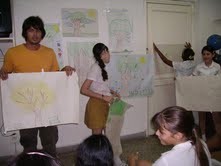
A Citizen Science Project undertaken by Ivan Borroto Rodriguez, M.S., Xochitl Ayon Guemes, M.S., and Frances Garcia Jimenez, M.S.
Introduction
June 5th 2011, World Environment Day, was the last day of the great journey, full of fantastic experiences, that the workshop “The trees, the birds of the city and I” represented for all participants. This Citizen Science workshop was the first one of its kind to take place at the National Museum of Natural History in Cuba. Twenty-five 7th graders from the middle school José Martí in Havana Vieja participated in the sessions, which started in December, 2010.
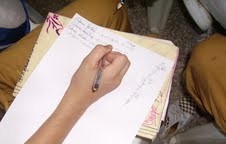
Our project had two stages: the first one was classroom-based and during this stage the participants established an environment of trust and collaboration, at the same time that they acquired the knowledge and training needed to monitor the bird populations. In the second stage, they carried out the monitoring sessions, gathering of data, analysis and discussion of the results. In both stages, the kids lead the way.
The monitoring sessions were done at two parks, located very close to the Museum: Plaza de Armas and Plaza La Maestranza. Both are in Havana Vieja’s Historical Downtown. The sessions took place on a monthly basis, from February to May of 2011. During the sessions, the participants conducted individual observations on four trees each from six different species, with the goal of observing and describing the growth phases of leaves, buds, flowers and fruits. These twenty-four trees were observed for ten minutes each time, to allow the kids to see the variety of bird species and the number of birds per specie that use each type of tree.

Britton).
Para facilitar el acopio de los datos, los niños contaron con: miniguía confeccionada para el proyecto con las aves más frecuentes de la Ciudad de la Habana, elaborado a partir de las ilustraciones tomadas de “A Guide to the Birds of the West Indies”, cortesía de Herbert-Raffaelle; planilla para recoger información y mini-mapas de los parques para facilitar la localización de los árboles, ambos diseñados intencionalmente para el proyecto.
The children used a mini-guide, which had illustrations of the most common birds in the city of Havana; the illustrations were copied from “A guide to the Birds of the West Indies” with permission granted by Herbert-Raffaelle; a form to write down the information and maps of the parks to ensure they could easily find the trees. All were custom made for this project.
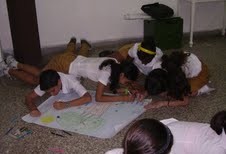
It was very interesting for the kids to “discover” the growth phases of leaves, flowers, buds and fruits on the trees as well as noticing the different species of birds that normally live in cities and the behaviors that they displayed during the monitoring sessions. All of this is normally unnoticed by the city dweller; however, it represents essential information for preservation programs focused on the local biodiversity.
The time the kids spent participating in activities allowed them to learn while expressing their personality traits, and this was one of the main reasons they were interested in the workshop. The activities were monitored to assure that they fulfilled the requirements to be used for a citizen science project.
It was very interesting to compare the drawings a “city tree” made by the children at the beginning of the workshop with the drawings made at the end: while the trees were similar, the final drawings also contained birds, people and signs of human activity. Bird songs were also present, represented as musical notes, meaning that the kids were paying attention and training their ear to listen for the bird calls and songs.
El dibujo de un árbol de ciudad realizado por los niños al comienzo y final del proyecto, se utilizó como una de las herramientas para aproximarnos a conocer posibles cambios en las percepciones de los niños hacia los árboles y su relación con el entorno citadino. Los dibujos de árboles corpulentos, altos y de copas con abundantes ramas y hojas, parecidos a nuestra Ceiba fueron una constante. Si embargo, la incorporación de nuevos elementos como: aves, figuras humanas y elementos propios de la actividad humana en sus dibujos finales marcó una diferencia sustancial entre el “antes y el después”. Importante resultó la representación del canto de las aves mediante el uso de notas musicales saliendo del pico de las aves, hecho que nos muestra el valor del sentido del oído ejercitado durante los meses de muestreo.
La retroalimentación de los participantes en cuanto a los esfuerzos de monitoreo se vio recompensada durante el proceso de obtención de los resultados y su entendimiento a partir de las contribuciones individuales.
The First Festival “Una Mirada a las Aves de la Ciudad” (“A look at the City Birds”) was applauded by the visitors, both Cubans and tourists, who were shown around by the kids that participated in the project. The Festival was promoted through Havana Radio and on the webpage of the Lab. of Ornithology (http://celebrateurbanbirds.org/community /sharing-our-communities/museo-nacional-de-historia-natural-de-cuba)
Si bien el análisis e interpretación de los datos y el entendimiento de los resultados se realizó en el último mes como se previó desde un inicio, los facilitadores en estos momentos hemos llegado a consenso en cuanto a que el desarrollo paulatino de estas etapas aparejado con la colecta y acopio de datos hubiera contribuido en mejor cuantía a la sedimentación de los conocimientos y la retroalimentación positiva a los esfuerzos de monitoreo.
What we observed during our four month monitoring period was:
- The timing of leaves, buds, flowers and fruit production differs among species.
- The production stages are not in the same order for all tree species.
- Twelve species of birds visited the trees we observed.
- The tree that had the most bird visitors was the kapok followed by the yellow Flamboyant (Fig. 1).
- The most common birds were house sparrow, rock dove and Eurasian collared dove, while the least common were the Greater Antillean Grackle, the Cuban Emerald and the Fieldfare (Fig. 2).
- We were able to confirm that the Palm Warbler is a winter visitor, as their numbers were decreasing, until they were almost all gone by May (Fig. 2).
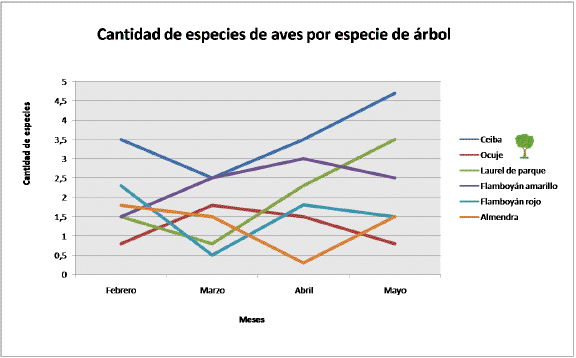
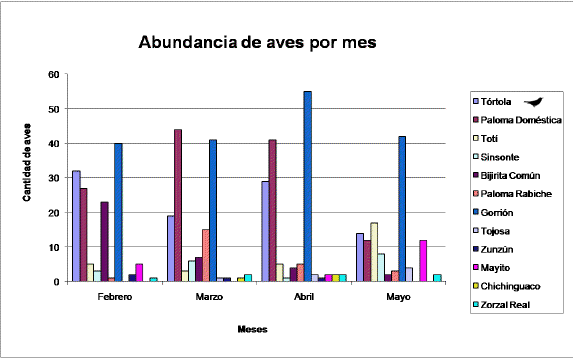
We are very grateful to the participants, to the Museum for welcoming and allowing the workshop to take place in its facilities, and to the Laboratory of Ornithology of the University of Cornell, particularly to Eduardo Iñigo Elías and Karen Purcell, for their advice and support.
Agradecimientos:
A los niños participantes en el taller, al colectivo del Museo que recibió la idea y permitió la realización de distintas acciones durante el taller, y al Laboratorio de Ornitología de Cornell en especial, a Eduardo Iñigo Elías y Karen Purcell por la asesoría y el apoyo en esta iniciativa. A todos los que no se mencionan, pero siempre estaremos agradecidos.
List of bird species found in six tree species in in the Plaza de Armas and Parque de la Maestranza, both in the city of Havana Vieja (Feb-Jun, 2011).
House Sparrow (Passer domesticus) – Introduced and established
Rock Dove (Columba livia) – Introduced
Eurasian Collared Dove (Streptopelia decaocto) – Introduced and
Established
Palm Warbler (Dendroica palmarum) – Winter Resident
Cuban Blackbird (Dives atroviolaceus) – Native
Mourning Dove (Zenaida macroura) – Permanent Resident
Tawny-shouldered Blackbird (Agelaius humeralis) – Permanent Resident
Northern Mockingbird (Mimus polyglottos) – Permanent Resident
Common Ground-Dove (Columbina passerina) – Permanent Resident
Red-legged Thrush (Turdus plumbeus) – Permanent Resident
Cuban Emerald (Clorostilbon ricordii) – Permanent Resident
Greater Antillean Grackle (Quiscalus niger) – Permanent Resident
Figure 1: Average number of bird species found in six different tree species that were monitored from February to May, 2011, in the Plaza de Armas and Parque de la Maestranza, both in the city of Havana Vieja.
Figure 2: Abundance of birds observed in the six tree species monitored from February to May, 2011, in the Plaza de Armas and Parque de la Maestranza, both in the city of Havana Vieja.